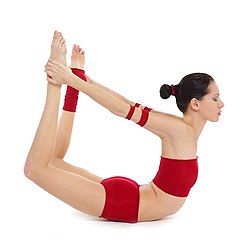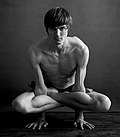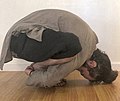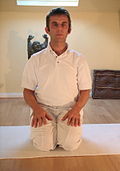Top Qs
Timeline
Chat
Perspective
List of asanas
List of postures in hatha yoga and yoga as exercise From Wikipedia, the free encyclopedia
Remove ads
An asana (Sanskrit: आसन, IAST: āsana) is a body posture, used in both medieval hatha yoga and modern yoga.[1] The term is derived from the Sanskrit word for 'seat'. While many of the oldest mentioned asanas are indeed seated postures for meditation, asanas may be standing, seated, arm-balances, twists, inversions, forward bends, backbends, or reclining in prone or supine positions. The asanas have been given a variety of English names by competing schools of yoga.[2]

The traditional number of asanas is the symbolic 84, but different texts identify different selections, sometimes listing their names without describing them.[3][a] Some names have been given to different asanas over the centuries, and some asanas have been known by a variety of names, making tracing and the assignment of dates difficult.[5] For example, the name Muktasana is now given to a variant of Siddhasana with one foot in front of the other, but has also been used for Siddhasana and other cross-legged meditation poses.[6] As another example, the headstand is now known by the 20th century name Shirshasana, but an older name for the pose is Kapalasana.[3][7] Sometimes, the names have the same meaning, as with Bidalasana and Marjariasana, both meaning Cat Pose.[8][9]
Remove ads
Affixes
Variations on the basic asanas are indicated by Sanskrit affixes including the following:
Remove ads
Asanas
Summarize
Perspective
A single asana is listed for each main pose, whether or not there are variations. Thus for Sirsasana (Yoga headstand), only one pose is illustrated, although the pose can be varied by moving the legs apart sideways or front-and-back, by lowering one leg to the floor, by folding the legs into lotus posture, by turning the hips to one side, by placing the hands differently on the ground, and so on. Iyengar's 1966 Light on Yoga lists 15 variations on the basic headstand, including for instance the combined variation Parivrttaikapada Sirsasana in which not only are the hips revolved but the legs are apart front-and-back.[10] Since then, variations of many other poses have been created; their names are not listed here.[11] Yin Yoga names are for the equivalent Yin variants; these are usually somewhat different from the conventional (Yang) poses.
Indian texts are "notoriously difficult to date".[12] The table shows the approximate date and abbreviated title of the earliest document or authority to describe that asana (not only naming it), as follows:
- AS = Ahirbudhnya Saṃhitā, c. 7th century
- BaH = Bahr al-Hayāt, 17th century
- DU = Darśana Upaniṣad, c. 4th century
- GhS = Gheraṇḍa Saṃhitā, 17th century
- GS = Gorakṣaśataka, 10th century
- HAP = Hațhābhyāsapaddhati, 18th century
- HR = Haṭha Ratnāvali, 17th century
- HY = Hemacandra's Yogaśāstra, 11th century
- HYP = Haṭha Yoga Pradīpikā, 15th century
- JP = Joga Pradīpikā, 18th century
- LoY = Light on Yoga, 1966
- PL = Post-Light on Yoga[b]
- PSV = Pātañjalayogaśāstravivaraṇa, 8th century
- ShS = Śiva Saṃhitā, 14th century
- ST = Śrītattvanidhi, 19th century
- TB = Theos Bernard, 1950
- TK = Tirumalai Krishnamacharya, c. 1940
- V = Vimānārcanākalpa, 10th century
- VM = Vivekamārtaṇḍa, 13th century
- VS = Vāsiṣṭha Saṁhitā, 13th century
Remove ads
See also
- Mudra – yoga gestures
- Pranayama – yoga breathing techniques
- Surya Namaskar – a foundational sequence of asanas
Notes
- 84's symbolism may derive from its astrological and numerological properties: it is the product of 7, the number of planets in astrology, and 12, the number of signs of the zodiac, while in numerology, 7 is the sum of 3 and 4, and 12 is the product, i.e. 84 is (3+4)×(3×4).[4]
- PL, Post-Light on Yoga poses, are marked as '21st C.' to sort late 20th as well as 21st century asanas after TK and LoY.
- Sjoman notes that the names of asanas have been used "promiscuous[ly]", making their history difficult to trace: the presence of matching names is not proof of continuity, since the same name may mean a different pose, and a pose may have been known by other names at different times.[5] The dates here are therefore based on documents which provide actual descriptions of the asanas.
- The Yin Yoga variants are similar but not identical to their 'Yang' equivalents.[13]
- GhS uses the name Garuḍāsana for a different pose.
- Not yet yoga in 1896 as Jhūla pose in Vyayama Dipika gymnastics book[86]
- This is a well-documented example of a post-Light on Yoga (1966) pose, created as a variation of the 20th century Warrior poses. Hundreds of less common variations of other poses have been created in the same time frame.
Remove ads
References
Sources
Wikiwand - on
Seamless Wikipedia browsing. On steroids.
Remove ads
























































































